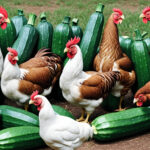As a flock owner or an avid backyard chicken enthusiast, you might ponder about the best diet for your feathered friends. Nutrition is paramount, and this leads to an essential question—can chickens have tomatoes? This seemingly simple inquiry unlocks a world of considerations for chicken keepers. Let’s dive into this topic and unearth the surprising truths surrounding chickens and tomatoes, ensuring that your chickens live their happiest and healthiest lives.
We all want what’s best for our chickens, and part of that is offering a diet that’s both nourishing and safe. Tomatoes, those vibrant, juicy staples that flourish in gardens worldwide, may be on your list of potential chicken treats. However, before you toss those ruby reds into the run, it’s vital to understand the nuances of tomatoes as a part of a chicken’s diet.
When it comes to the inclusion of tomatoes in a mosaic chicken‘s diet, there are several key factors to consider. This article addresses common concerns, dispels myths, and provides you with comprehensive insights into whether your flock can safely indulge in this popular fruit.
The Chicken and the Tomato: A Nutritional Breakdown
Before deciding if chickens can have tomatoes, let’s understand the nutritional content of tomatoes and how they align with a chicken’s dietary needs.
Tomatoes are packed with:
- Vitamins: They boast high levels of vitamin C, vitamin K, and an assortment of B vitamins.
- Minerals: Potassium, manganese, and magnesium are some of the minerals found in tomatoes.
- Antioxidants: Lycopene, the compound that gives tomatoes their red color, is a powerful antioxidant.
Although these are beneficial components, chickens require a well-rounded diet that mainly consists of formulated feed designed for their specific life stage. Treats like tomatoes should only be supplementary.
Tomatoes in Moderation: The Rule of Thumb for Feeding Fowl
The key to safely introducing tomatoes into your chicken’s diet lies in one word – moderation. It’s crucial that they make up no more than 10% of a chicken’s daily intake, ensuring the primary food still remains a complete feed that provides all the essential nutrients.
The Parts of the Tomato: What’s Safe and What’s Not
Not all parts of the tomato are equal in the eyes of chicken health. The ripe fruit is generally safe, but the plant itself has parts that are toxic.
Safe:
- Ripe red tomatoes
Unsafe:
- Green, unripe fruit
- Leaves
- Stems
- Flowers
The toxic substance in question is solanine, a glycoalkaloid found in the nightshade family, which can be harmful to chickens in large amounts.
The Good: Benefits of Tomatoes for Chickens
Tomatoes can be a healthy addition to chicken diets when given correctly. The benefits of tomatoes for chickens are notable:
- Boosting Immune Systems: The vitamins in tomatoes help in strengthening the immune system.
- Antioxidant Properties: Lycopene and other antioxidants can aid in preventing cellular damage.
- Hydration: Tomatoes are high in water content, offering a hydrating snack, especially in warmer temperatures.
Nutrition Versus Treats: Balancing the Tomato Equation
While the nutritional perks are promising, tomatoes should remain as treats, not the cornerstone of a chicken’s diet. Remember to always offer a balanced menu that fulfills their nutritional needs first.
Segregation of Tomato Parts: What to Feed
It is imperative to separate the safe parts of the tomato from those containing solanine. Never offer green parts of the plant to chickens; instead, only provide ripe, red fruit, cut into appropriate sizes for easy consumption.
The Bad: Potential Risks of Tomatoes to Chickens
While tomatoes can be a nutritious snack, there are risks involved if not managed properly:
- Solanine Toxicity: As mentioned, the green parts of a tomato plant, including the leaves and stems, contain solanine, which is toxic to chickens.
- Overconsumption: Overindulgence can lead to nutritional imbalances, with tomatoes taking the place of more nutritionally complete feeds.
- Pesticides and Chemicals: Store-bought or garden-grown tomatoes might be treated with pesticides that can be harmful to your chickens.
Monitoring and Mitigation: How to Avoid Tomato-Related Issues
To avoid potential tomato-related risks, it’s essential to:
- Supervise Treat Time: Always keep an eye out to ensure chickens aren’t consuming the wrong parts of the plant.
- Limit Quantity: Stick to the 10% treat rule to avoid nutritional imbalances.
- Go Organic: If possible, offer organic tomatoes to reduce the exposure to pesticides.
Recognizing Toxicity Symptoms: What to Look For
If you suspect your chicken has ingested the green parts of a tomato plant, look for symptoms of solanine poisoning, including lethargy, weakness, and gastrointestinal distress. Seek veterinary care if symptoms are noted.
The Ugly: Myths and Facts About Chickens and Tomatoes
Myths about chickens and tomatoes abound. It’s time to separate fact from fiction.
Myth #1: All Tomatoes Are Bad for Chickens
This is a myth. Only the green, unripe portions of the plant are hazardous. Ripe tomatoes can be part of a healthy diet for chickens.
Myth #2: Chickens Can Self-Regulate and Avoid Toxic Plants
Chickens do have an instinct to avoid certain plants, but it’s not foolproof. Relying solely on their instincts can be dangerous.
Myth #3: Tomato Skins and Seeds Should Be Avoided
In truth, the skins and seeds of ripe tomatoes pose no harm to chickens and can be part of the treat you offer them.
Integrating Tomatoes into Your Chicken’s Diet
When properly integrated, tomatoes can enhance your chickens’ diet. Here’s how to do it:
- Introduce Tomatoes Slowly: Start with small pieces of ripe tomato to see how your chickens react.
- Mix with Other Safe Treats: Consider offering tomatoes alongside other chicken-safe fruits and vegetables for variety.
Seasonal considerations: When to Offer Tomatoes
Tomatoes are best offered in moderation during their growing season, when they are most natural and nutrient-rich.
Preparing Tomatoes for Chickens: Best Practices
Preparing tomatoes for chicken consumption involves removing any green areas and slicing the fruit into manageable pieces—this helps prevent choking and ensures easy digestion.
In Closing: A Balanced View on Chickens and Tomatoes
To summarize, chickens can have tomatoes as part of a well-rounded diet. The occasional ripe tomato treat can be beneficial, but it’s vital to avoid the green, unripe parts of the plant that pose a toxic threat. Moderation, supervision, and safe food preparation are the cornerstones of incorporating tomatoes into your chickens’ dietary repertoire.
Ensuring the health and well-being of your flock requires informed decisions about their diet. Tomatoes, when offered judiciously, can contribute to a varied and enjoyable treat experience for your chickens without sacrificing nutrition. So the next time you’re in the garden or at the grocery store, feel confident in picking up a tomato for your feathered companions, keeping in mind the insight from this comprehensive guide.
Emerging from the plethora of information on what chickens should and shouldn’t eat, the verdict on tomatoes is clear. As surprising as it may be, chickens can indeed enjoy the juicy goodness of ripe tomatoes, with a heedful approach. This understanding of chickens’ dietary needs not only promotes their health but also amplifies the satisfaction of tending to a thriving, contented flock.







